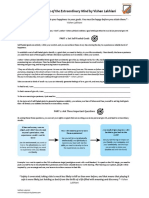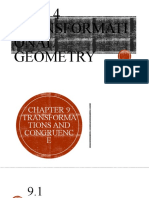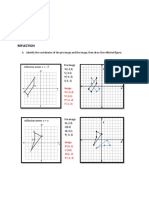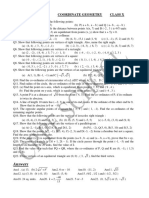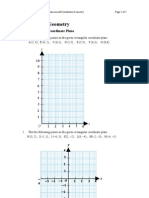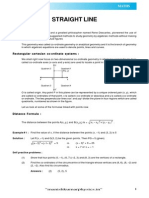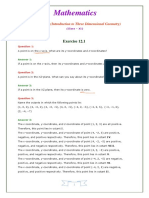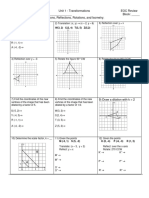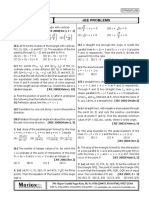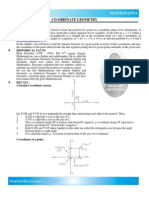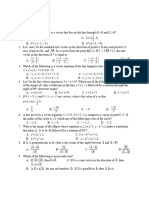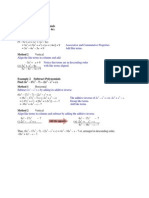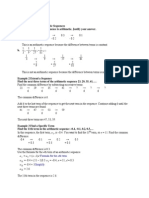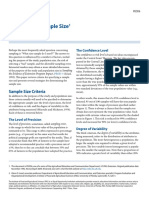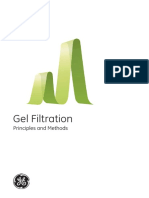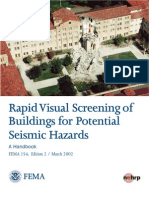Professional Documents
Culture Documents
Math Lesson 4 - 2
Math Lesson 4 - 2
Uploaded by
cermatikaOriginal Description:
Original Title
Copyright
Available Formats
Share this document
Did you find this document useful?
Is this content inappropriate?
Report this DocumentCopyright:
Available Formats
Math Lesson 4 - 2
Math Lesson 4 - 2
Uploaded by
cermatikaCopyright:
Available Formats
Lesson 4-2 Example 1 Identify Transformations Identify each transformation as a reflection, translation, dilation, or rotation. a. b.
c.
d.
a. b. c. d.
The figure has been increased in size. This is a dilation. The figure has been shifted horizontally to the right. This is a translation. The figure has been flipped over a line. This is a reflection. The figure has been turned around a point. This is a rotation.
Example 2 Reflection A pentagon has vertices A(-3, 1), B(-1, 1), C(0, 3), D(-2, 4), and E(-4, 3). a. Pentagon ABCDE is reflected over the y-axis. Find the coordinates of the vertices of the image. To reflect the figure over the y-axis, multiply each x-coordinate by 1. (x, y) A(-3, 1) B(-1, 1) C(0, 3) D(-2, 4) E(-4, 3) ! ! ! ! ! ! (-x, y) A(3, 1) B(1, 1) C (0, 3) D(2, 4) E(4, 3)
The coordinates of the vertices of the image are A(3, 1), B(1, 1), C (0, 3), D(2, 4), and E(4,3). b. Graph pentagon ABCDE and its image ABCDE. Graph each vertex of the pentagon ABCDE. Connect the points. Graph each vertex of the reflected image ABCDE. Connect the points.
Example 3 Translation Parallelogram QRST has vertices Q(-2, 1), R(1, 1), S(3, 3), and T(0, 3). a. Find the coordinates translated 1 unit to the right and 3 units up. To translate the parallelogram 1 unit to the right, add 1 to the x-coordinate of each vertex. To translate the parallelogram 3 units up, add 3 to the y-coordinate of each vertex. (x, y) ! (x + 1, y + 3) Q(-2, 1) ! Q(-2 + 1, 1 + 3) R(1, 1) ! R(1 + 1, 1 + 3) S(3, 3) ! S (3 + 1, 3 + 3) T(0, 3) ! T(0 + 1, 3 + 3) ! ! ! ! Q(-1, 4) R(2, 4) S (4, 6) T(1, 6)
The coordinates of the vertices of the image are Q(-1, 4), R(2, 4), S(4, 6), and T(1, 6). b. Graph parallelogram QRST and its image. The preimage is parallelogram QRST. The translated image is parallelogram QRST.
Example 4 Dilation A triangle has vertices X(1, 2), Y(3, 6), and Z(-2,3). a. Find the coordinates of the dilated triangle XYZ if the scale factor is 2. To dilate the figure multiply the coordinates of each vertex by 2. (x, y) ! (2x, 2y) X(1, 2) ! X(2 1, 2 2) ! X(2, 4) Y(3, 6) ! Y(2 3, 2 6) ! Y(6, 12) Z(-2, 3) ! Z (2 (-2), 2 3) ! Z (-4, 6) The coordinates of the vertices of the image are X(2, 4), Y(6, 12), and Z(-4, 6). b. Graph the preimage and its image. The preimage is the triangle XYZ. The image is the triangle XYZ. Notice that the image has sides that are two times the length of the sides of the original figure.
Example 5 Rotation Trapezoid ABCD has vertices A( 2, -1), B(-6, -1), C(-4, -5), and D(0, -5). a. Find the coordinates of the image of trapezoid ABCD after it is rotated 180 about the origin. To find the coordinates of the vertices after a 180 rotation, multiply both coordinates of each point by 1. (x, y) ! (-x, y) A(2, -1) ! A(-2, 1) B(-6, -1) ! B(6, 1) C(-4, -5) ! D(4, 5) D(0, -5) ! E(0, 5) b. Graph the preimage and its image. The image is trapezoid ABCD. The rotated image is trapezoid ABCD.
You might also like
- Holcomb Chapter 3Document21 pagesHolcomb Chapter 3api-244761274100% (2)
- Lesson Plan Cesar Chavez 2Document3 pagesLesson Plan Cesar Chavez 2api-285536206No ratings yet
- Transformations Review 2Document3 pagesTransformations Review 2api-293228282No ratings yet
- Math Lesson 8 - 7Document2 pagesMath Lesson 8 - 7cermatikaNo ratings yet
- The Code of The Extraordinary MindDocument1 pageThe Code of The Extraordinary MindAvi K. Shrivastava100% (1)
- Dynamic Inversion An Evolving Methodology For Flight Control DesignDocument22 pagesDynamic Inversion An Evolving Methodology For Flight Control DesignPanos VitsasNo ratings yet
- Cesar Chavez NearpodDocument10 pagesCesar Chavez Nearpodapi-480602242No ratings yet
- Resource Guide:: Supporting Undocumented YouthDocument63 pagesResource Guide:: Supporting Undocumented Youthcorey_c_mitchellNo ratings yet
- Unit 4Document30 pagesUnit 4api-525019368No ratings yet
- Unit2 5.2.1 and 5.2.2Document44 pagesUnit2 5.2.1 and 5.2.2Mrs. LaraNo ratings yet
- Transformations Study GuideDocument3 pagesTransformations Study GuidecrystalMorgan123No ratings yet
- Matrix TransformDocument8 pagesMatrix TransformJ Christopher ClementNo ratings yet
- Geometric Transformation-1Document41 pagesGeometric Transformation-1Jocelin NatashaNo ratings yet
- Reflection: Sebongga, Emman Ace P. BS Pharma 2BDocument6 pagesReflection: Sebongga, Emman Ace P. BS Pharma 2BEMMAN ACE SEBONGGANo ratings yet
- 8 3 RotationsDocument6 pages8 3 RotationsYASSIEN ELBANNANo ratings yet
- Worksheet 2 - TransformationDocument19 pagesWorksheet 2 - TransformationShnia RodneyNo ratings yet
- Straight LinesDocument127 pagesStraight LinesVIDYA SRI GANESHNo ratings yet
- LinearTransformations PDFDocument8 pagesLinearTransformations PDFCorneliusNo ratings yet
- Chapter 5 Transformations of The Euclidean PlaneDocument14 pagesChapter 5 Transformations of The Euclidean PlaneLitoy ArquizaNo ratings yet
- Coordinate GeometeryDocument10 pagesCoordinate Geometerynancy goelNo ratings yet
- Coordinate Geometry 1Document2 pagesCoordinate Geometry 1ConnieChenNo ratings yet
- Transformational Geometry -TranslationsDocument32 pagesTransformational Geometry -Translationsprincessdls20No ratings yet
- Glide ReflectionDocument19 pagesGlide ReflectionRyan Christian DioknoNo ratings yet
- Co Ordinate X Class NewDocument2 pagesCo Ordinate X Class NewMikasa AckermanNo ratings yet
- Dpp-2 English PC BwyryeuDocument7 pagesDpp-2 English PC Bwyryeum2595jn9d9No ratings yet
- LESSON1: Distance Between Two Points: Module: 1: Week: 1: Quarter: 1Document14 pagesLESSON1: Distance Between Two Points: Module: 1: Week: 1: Quarter: 1Marianne Peligro MarasiganNo ratings yet
- Geometry-HS-V2-Workbook GéometrieDocument79 pagesGeometry-HS-V2-Workbook GéometrieJulie Bergeron-AllardNo ratings yet
- Co-Ordinate X ClassDocument2 pagesCo-Ordinate X ClassCRPF SchoolNo ratings yet
- Revision Sheet G10 - Solved PDFDocument5 pagesRevision Sheet G10 - Solved PDFAlaeddine AzaiezNo ratings yet
- Represented by The Equation X+y 2.: Question/Task/ExerciseDocument14 pagesRepresented by The Equation X+y 2.: Question/Task/ExerciseMuhammad Raza RafiqNo ratings yet
- Physicswala Math- 18Document21 pagesPhysicswala Math- 18arghadeepmandal1No ratings yet
- Chapter 2 解析几何(AMC10)Document18 pagesChapter 2 解析几何(AMC10)Xuemei zhangNo ratings yet
- MATHS Revision DPP No 2Document8 pagesMATHS Revision DPP No 2ashutosh100% (2)
- Home Practice AS Maths 1120: DifferentiationDocument3 pagesHome Practice AS Maths 1120: DifferentiationHeh BlehNo ratings yet
- CH 12Document15 pagesCH 12Adarsha NNo ratings yet
- 4 Dilation - Day 2Document2 pages4 Dilation - Day 2MMTotmanRangeviewNo ratings yet
- Co-Ordinate Geometry PDFDocument39 pagesCo-Ordinate Geometry PDFshyamNo ratings yet
- Coordinate GeometryDocument3 pagesCoordinate Geometryizatul nazirahNo ratings yet
- Transformation 10Document26 pagesTransformation 10Freak LearnerNo ratings yet
- S3 Coordinate GeometryDocument5 pagesS3 Coordinate GeometryhoihoihoihahahaNo ratings yet
- Chapter 11 Geometry in Space and VectorsDocument42 pagesChapter 11 Geometry in Space and VectorsaminaNo ratings yet
- Straight LineDocument24 pagesStraight LineAditya Bansal100% (1)
- Reflections PowerpointDocument15 pagesReflections Powerpointapi-513958066No ratings yet
- Co-Ordinate Geometry: The X - Y PlaneDocument8 pagesCo-Ordinate Geometry: The X - Y PlaneAishwarya RaviNo ratings yet
- Mathematics: (Chapter - 12) (Introduction To Three Dimensional Geometry)Document17 pagesMathematics: (Chapter - 12) (Introduction To Three Dimensional Geometry)Anji KaringuNo ratings yet
- Review Sheet For Test 1Document16 pagesReview Sheet For Test 1Y D Amon GanzonNo ratings yet
- Unit 1 Transformations Eoc Review 2018Document3 pagesUnit 1 Transformations Eoc Review 2018clara.hyun.baeNo ratings yet
- And Geometl : of Calcuhis AnalyticDocument564 pagesAnd Geometl : of Calcuhis Analyticsonasonaaaa934No ratings yet
- Three Dimensional SpaceDocument46 pagesThree Dimensional SpaceSamuel ArquilloNo ratings yet
- 8 2 ReflectionsDocument6 pages8 2 ReflectionsYASSIEN ELBANNANo ratings yet
- Coordinate GeometryDocument5 pagesCoordinate Geometryapi-382522350% (2)
- Xercise: Jee ProblemsDocument2 pagesXercise: Jee ProblemspandaNo ratings yet
- Coordinate GeometryDocument32 pagesCoordinate GeometrythinkiitNo ratings yet
- Units: MATH 3 - Precalculus Review Engr. Rodge Ursua Page 1 of 6Document6 pagesUnits: MATH 3 - Precalculus Review Engr. Rodge Ursua Page 1 of 6ShineNo ratings yet
- W-Second QDocument7 pagesW-Second QTSEGAYE HILEMICHAELNo ratings yet
- Introduction To Three Dimensional Coordinate Geometry: Chapter - 12Document3 pagesIntroduction To Three Dimensional Coordinate Geometry: Chapter - 12Ankit TiwariNo ratings yet
- Conic Section DPPDocument63 pagesConic Section DPPRahul Jain87% (23)
- C1 Sec 3Document11 pagesC1 Sec 3NombuleloNo ratings yet
- S4 Maths - Exam (Ans)Document9 pagesS4 Maths - Exam (Ans)Natalie Yeung100% (1)
- Strategic Intervention Material: (Equation of A Line)Document17 pagesStrategic Intervention Material: (Equation of A Line)Ernalyn Apostol BalicatNo ratings yet
- Graph of LE 1Document17 pagesGraph of LE 1Ernalyn Apostol BalicatNo ratings yet
- CH 12 - Introduction To 3 Dimensional - GeometryDocument15 pagesCH 12 - Introduction To 3 Dimensional - GeometryX gamerNo ratings yet
- GR 12 l10 Transformation1Document11 pagesGR 12 l10 Transformation1Njabulo DlaminiNo ratings yet
- Unknown PDFDocument13 pagesUnknown PDFEricka Faye0% (1)
- Math Lesson9 - 6 PDFDocument3 pagesMath Lesson9 - 6 PDFcermatikaNo ratings yet
- Math Lesson9 - 5Document3 pagesMath Lesson9 - 5cermatikaNo ratings yet
- Math Lesson 8 - 6Document2 pagesMath Lesson 8 - 6cermatikaNo ratings yet
- Math Nlesson 9 - 2 PDFDocument2 pagesMath Nlesson 9 - 2 PDFcermatikaNo ratings yet
- Math Nlesson 9 - 2 PDFDocument2 pagesMath Nlesson 9 - 2 PDFcermatikaNo ratings yet
- Math Lesson 9 - 3 PDFDocument3 pagesMath Lesson 9 - 3 PDFcermatikaNo ratings yet
- Math Lesson 8 - 8Document2 pagesMath Lesson 8 - 8cermatikaNo ratings yet
- Math Lesson 8 - 2Document3 pagesMath Lesson 8 - 2cermatikaNo ratings yet
- Math Lesson 8 - 5Document2 pagesMath Lesson 8 - 5cermatikaNo ratings yet
- Math Lesson 7 - 1Document2 pagesMath Lesson 7 - 1cermatikaNo ratings yet
- Math Lesson 8 - 4Document2 pagesMath Lesson 8 - 4cermatikaNo ratings yet
- Math Lesson 6 - 5Document2 pagesMath Lesson 6 - 5cermatikaNo ratings yet
- Math Lesson 8 - 1 PDFDocument2 pagesMath Lesson 8 - 1 PDFcermatikaNo ratings yet
- Math Lesson 4 - 5Document3 pagesMath Lesson 4 - 5cermatikaNo ratings yet
- Math Lesson 6 - 1 PDFDocument2 pagesMath Lesson 6 - 1 PDFcermatikaNo ratings yet
- Math Lesson 6 - 4Document3 pagesMath Lesson 6 - 4cermatikaNo ratings yet
- Math Lesson 4 - 8Document3 pagesMath Lesson 4 - 8cermatikaNo ratings yet
- Math Lesson 4 - 7Document2 pagesMath Lesson 4 - 7cermatikaNo ratings yet
- Math Lesson 4 - 6Document4 pagesMath Lesson 4 - 6cermatikaNo ratings yet
- Example 1 Solve Using A Replacement SetDocument2 pagesExample 1 Solve Using A Replacement SetcermatikaNo ratings yet
- Example 1 Represent A Relation: Y-Coordinates in The Second ColumnDocument2 pagesExample 1 Represent A Relation: Y-Coordinates in The Second ColumncermatikaNo ratings yet
- Steel Detailer Listing: Note To DetailersDocument6 pagesSteel Detailer Listing: Note To DetailersNoore Alam SarkarNo ratings yet
- Divide and Conquer Divide and Conquer: CS404/504 Computer Science 1 Design and Analysis of Algorithms: Lecture 8Document14 pagesDivide and Conquer Divide and Conquer: CS404/504 Computer Science 1 Design and Analysis of Algorithms: Lecture 8venky_venkat63No ratings yet
- Updated G10 Class Routine Effective From 12 January 2023Document1 pageUpdated G10 Class Routine Effective From 12 January 2023NiloyNo ratings yet
- Human Behavior in Organizations: Topics: Pages: PublishedDocument4 pagesHuman Behavior in Organizations: Topics: Pages: PublishedMarianito TanNo ratings yet
- Research Ethics FaaizahDocument55 pagesResearch Ethics FaaizahSiti Nur Azrreen RuslanNo ratings yet
- E Sunday SchoolDocument20 pagesE Sunday SchoolRene Gene del BarrioNo ratings yet
- Kindergarten-DLL-MELC-Q1-Week 7 AsfDocument8 pagesKindergarten-DLL-MELC-Q1-Week 7 AsfJanes Soria Abarientos ArquinezNo ratings yet
- Personal Learning Plans in Medical EducationDocument12 pagesPersonal Learning Plans in Medical EducationIsa Mara AlvesNo ratings yet
- 2 Glenn D. Israel Determining Sample SizeDocument5 pages2 Glenn D. Israel Determining Sample SizePradeep PandianNo ratings yet
- GRE Writing TipsDocument2 pagesGRE Writing TipsGrassrehLe100% (2)
- Feministic Analysis of Manju Kapur's A Married WomanDocument7 pagesFeministic Analysis of Manju Kapur's A Married WomanKritika BazethaNo ratings yet
- Taguchi's Ina Seito Tile ExperimentDocument8 pagesTaguchi's Ina Seito Tile ExperimentSumit GuptaNo ratings yet
- Louise Cook Tonkin, 2015 Plenary Presentation On The Timor-Leste National Qualifications FrameworkDocument38 pagesLouise Cook Tonkin, 2015 Plenary Presentation On The Timor-Leste National Qualifications FrameworkPapers and Powerpoints from UNTL-VU Joint Conferenes in DiliNo ratings yet
- For and Against EssaysDocument11 pagesFor and Against EssaysSilvana R. BorghiNo ratings yet
- EMC Avamar 7.1 For SQL Server: User GuideDocument176 pagesEMC Avamar 7.1 For SQL Server: User GuideMohammed ShakeelNo ratings yet
- UBD HazdayDocument3 pagesUBD HazdayVartyYeremianNo ratings yet
- Gel FiltrationDocument123 pagesGel FiltrationZulfikri Asmardi RaufNo ratings yet
- An Assessment of The Nigerian Architects' Role Towards Climate Change and Global Warming in The Built EnvironmentDocument67 pagesAn Assessment of The Nigerian Architects' Role Towards Climate Change and Global Warming in The Built EnvironmentNaseeb KuramiNo ratings yet
- UNIT-4 Verification Plan: LVS-22 Vlsi Testing and VerificationDocument8 pagesUNIT-4 Verification Plan: LVS-22 Vlsi Testing and VerificationSanthoshReddyNo ratings yet
- Feedforward Assignment 02Document14 pagesFeedforward Assignment 02TiffanyNo ratings yet
- Capstone Update 1Document2 pagesCapstone Update 1api-690036995No ratings yet
- ProbabilityDocument35 pagesProbabilityJakia SultanaNo ratings yet
- Umesh 156340007 Psychoanalysis Film TheoryDocument10 pagesUmesh 156340007 Psychoanalysis Film TheoryTrottTamilNo ratings yet
- Komuniti PLCDocument19 pagesKomuniti PLCCT BarokahNo ratings yet
- Rapid Visual Screening of Buildings For Potential Seismic HazardsDocument164 pagesRapid Visual Screening of Buildings For Potential Seismic HazardsPO Asselin100% (2)
- MSDS Alkacide PDFDocument11 pagesMSDS Alkacide PDFSandy HidayatNo ratings yet
- Imantanout LLGDDocument4 pagesImantanout LLGDNABILNo ratings yet




